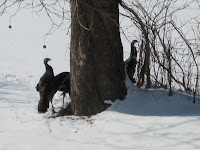The Master Gardener program through the Cooperative Extension Service is a wonderful thing. Programing through local organizations bring the beauty and science of horticulture right to our hometowns in living color. Such was the case last night when my county association hosted Russ Vernon of
New Vision Orchids as our program for the evening. What a delight during the dead of winter!
Russ, a horticulture graduate of Ohio State University, began his love of orchids at age 12. He very easily conveyed orchid culture to our group and repotted a couple of specimens as a demonstration. It is always so great when speakers bring visual aids, and Russ had a nice assortment of them. One, of course, came home with me even though I had to bum a few dollars from my friend Judy to make the purchase.
One of the most important things that we learned from Russ is that orchids need a ten degree difference in temperature for a two to three week period to induce blooming. Many people have a plant with lots of foliage, but no blooms are set because they stay in a consistent indoor temp of 65 - 70 degrees day and night. So to get the blooms to set, either set back your thermostat at night or set up an environment that will have a ten degree range.
My friend Diane has no trouble with orchids and getting them to rebloom. She has them in the house across from a west facing window. They keep the house cool during the winter, but the orchids get warmer temps in the afternoon when the western sun warms their area. In the summer, she does not run her air conditioning, but instead leaves the windows open. So the ten degree phenomenon happens naturally.
The second really important issue that we learned is about watering with an ice cube. Listen up! It is NOT a good watering method. The water does not move evenly and completely through the potting mix. Even though some orchid distributors list this as a watering technique on their label, do not do it. Remember, they need for you to keep buying orchids to stay in business. Proper watering is done with distilled water once every 7 - 11 days. The water should be allowed to run through the medium and drain out. If the water that drains out is tan colored, it could be an indication of mineral build up which means you need to replace the potting mix.
Speaking of minerals, Russ very simply explained the interaction of plants and minerals. Plants do need minerals for healthy growth, but the issue is having the minerals available in the right pH environment for the roots to be able to take them up. So it is important to know the pH range needed by a particular plant. The pH of the water can be adjusted or you can use mineral free water. Using water with minerals, and not adjusting the pH for the plant results in accumulated minerals in the potting mix which is probably like never washing your hands. EEEWWW! So do a little research about your houseplants to find out what they need to thrive.
I can't begin to share all of the information that we learned. If there are any orchid collections near where you live, you should go visit. Russ is involved with the
Wheeler Orchid Collection and Species Bank at Ball State University in Muncie, Indiana. He said that a good time to visit is late March and into April then again in November. Another excellent resource is the
American Orchid Society. You do need to be a member to access some of their resources, but that will be money well spent.
By the way, the other wonderful thing about the Master Gardener program is "Helping Others Grow" which is the point in sharing this information with you about orchids. If even one of you quits putting ice cubes on your potted plants as a watering technique, progress has been made.






























